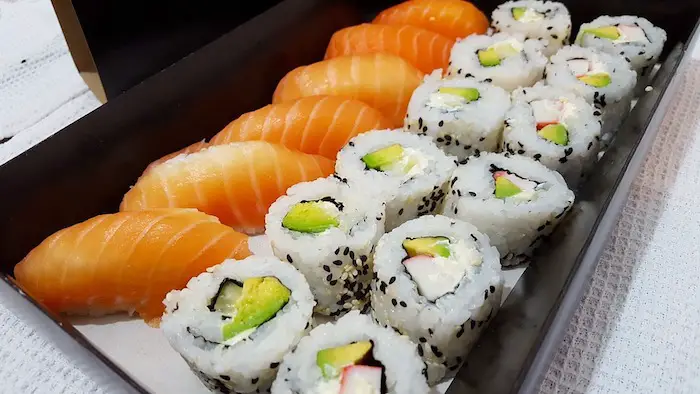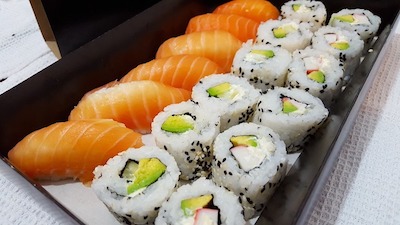We are reader supported. When you purchase through links on our site, we may earn an affiliate commission. Also, as an Amazon affiliate, we earn from qualifying purchases.

You’re a big sushi fan, and you want to eat sushi all the time, even when you’re sick? But can you eat it? Is it healthy? Imagine if you have a cold, or even worse, the flu, and you want to eat sushi so badly. The question is if you could eat sushi when you’re sick or would it make it even worse.
Well, there is no unique answer to this question. It all comes down to you and even what kind of disease you have. If it’s an ordinary cold or flu, then go for it and also add extra wasabi – it will open your sinuses. But if it’s something more severe like food poisoning to wait for a little would be a better idea.
Even though there is no right or wrong answer to this, we can positively say that any time is a good time for sushi! It would be best to eat whatever you feel like eating, even when you are sick. Any other concerns about sushi? After reading this article, you won’t have any left.
Eating Sushi When Sick
You’re lying in your bed sick and dreaming about eating one delicious sushi roll. But after remembering you are sick, you are not really sure if you can eat it?
It all comes down to what type of illness you have and what are your wishes. For example, if you have regular cold eating sushi could even be a good thing! Add a lot of wasabi to your sushi, and you will start breathing soon because the wasabi will clear your sinuses.
Same goes if you have mild flu and you’re craving a sushi roll. It’s a healthy alternative to some other fast foods like pizza or hotdogs that you also want to eat. Sushi is basically rice with vinegar and raw fish or vegetables, so it’s a healthy source of vitamins too. And you need all the vitamins you can get when you’re sick!
But, if you had some more severe diseases where you need to be on a particular food regime like some food poisoning or stomach bacteria, we recommend that you wait until you are healthy again.
It’s then better to wait when your immune system is fully recovered and not compromised. Not that sushi would make you sicker, but the combination of raw fish and rice would not be the best type of food if you’re recovering from food poisoning. Wait a week or so, until your fully cured and then you can hop on to eating sushi again!
Is Eating Sushi Healthy?
People generally consider sushi to be a healthy meal, especially in contrast to any fast food option like pizza or burgers. But there are some concerns over some ingredients in sushi and the risk of food poisoning with them. Let’s clear this topic up.
Traditional sushi has all the benefits of healthy food – fresh fish, vinegared rice and all that wrapped in seaweed sheets. This type of roll is full of omega-3 fatty acids (that can be found in fish like salmon) that are linked to numerous health benefits like fighting heart disease and diabetes. Raw fish is one of the best ways to get all the advantages of omega-3 fatty acids.
Moreover, this type of sushi roll is full of proteins, and it turns out to be an ideal after-workout meal. So, if you’re on the lookout for a high-protein snack choose tuna or salmon roll, which has at least 20 grams of protein per roll.
Related article: http://time.com/5241681/is-sushi-healthy/
Furthermore, commonly used vegetables like cucumber and avocado are an excellent source of vitamins like B1, B6 and E, fiber and the good fast. Seaweed that is used to roll the sushi is also a great source of protein and minerals such as iodine, zinc and vitamin B12.
All in all, sushi can be very healthy food, especially if you keep it simple and fill it with omega-3 rich raw fish, vegetables and rice. But this healthy glory sushi has can easily drop depending on how you prepare and eat the roll.
Related article: https://www.bbcgoodfood.com/howto/guide/sushi-healthy
A small piece of sashimi can’t be equally measured to spicy tuna roll dipped in soy sauce. The Western type of sushi is often filled with almost everything. From high-calorie ingredients like cream cheese, mayonnaise to fried food like tempura. This kind of sushi roll can have more than 500 calories.
This kind of sushi roll can be three times fattier than a plain California Roll. Also, soy sauce is often very high in salt, so keep an eye on the dipping and make sure to dip only your fish, not the whole roll.
One other problem is how to control yourself with portions. Because sushi is so small and packed in rolls, you don’t have a clear picture of how much are you actually eating. It looks small, but a single roll cut into six pieces can have 500 calories.
The conclusion – when eating sushi, less is more. Keep your sushi rolls simple, sea-food rich and filled with healthy vegetables.
How to Make Your Sushi Healthier
Nevertheless, sushi can be a healthy part of your nutrition as long as you are careful about its ingredients.
The ingredients that are rolled inside are the critical factor if your roll is healthy or not. Make sure your roll includes fish, fresh vegetables and a small amount of rice — the simpler, the healthier.
Stay away from mayonnaise and cream cheese sauces or even fried and battered vegetables. These may look tempting, but they are not healthy and are filled with extra calories!
You should take care of your dips and sauces too. Exaggerating with them can increase the sodium and fat levels in your healthy sushi. For instance, dipping the sushi in spicy mayo will only make your sushi full of fat and calories. Instead, add just a touch for the flavor.
Regarding the soy sauce, if you can’t eat your sushi without it, just sprinkle it on the fish, don’t dive your sushi roll in it. On the other hand, some ingredients like ginger are full of healthy nutrients. Ginger has anti-inflammatory benefits and is a fantastic source of vitamin C. So, with ginger between sushi you can’t be wrong.
If you want your sushi roll to be a clear and healthy mix – choose the brown rice instead. Brown rice will fill you up more and it’ high with fiber.
More information you can find on: http://time.com/5241681/is-sushi-healthy/
Lastly – keep an eye on the portions of your sushi rolls. It’s very easy to think you are not eating a lot when it comes in a bite-sized portion, but the calories still count. Eating more than 8-10 pieces per meal is not recommended.
Wrap your sushi in vegetables like cucumber or order sashimi, sliced raw fish with no rice, if you want the perfect healthy meal.
Related Questions
Is Sushi Safe to Eat?
Many people feel unsafe to eat raw fish and sushi because they are used to cooking all the meat and fish that they eat. They are scared of some diseases if eating something fresh and raw.
However, raw fish is perfectly safe to eat if it is prepared and handled correctly. Still, people are eating sushi for centuries, and many people are still eating it today.
To make raw fish safety to eat, it needs to go a different process, which is simple and effective and most of all – required by food safety law.
The FSA (Food Standards Agency) has a strict process for a business that serves raw fish. Firstly, they must source sushi fish from suitable sources then they must store them under specific deep-freezing conditions, and lastly prepare them hygienically.
This proper way of sourcing, storing and preparing is crucial to avoid any contaminations and parasites.
Therefore, be picky about where you eat your sushi. If they follow these standards, then the sushi is safe to eat.
Read more on: https://www.highspeedtraining.co.uk/hub/is-sushi-safe-to-eat/
Can I Eat Sushi if I’m Pregnant?
Even though there are some concerns and debates of eating raw fish while pregnancy, you can eat sushi but make sure the fish has been previously frozen and is from a source or restaurant that you trust. If the fish is fresh and it wasn’t frozen, it can contain small parasites called anisakis worms.
These can make you ill and hurt you and the baby. But with freezing raw fish, it will kill all the parasites and makes it safe to eat. So as long as the restaurant or you if you are making homemade sushi, follow standard hygiene practices, you’re fine to eat sushi.
Moreover, sushi that uses cooked fish and shellfish, such as crab, cooked prawns, and cooked eel, is fine to eat while pregnant. And don’t forget vegetarian sushi – which often contains cooked egg or avocado, is super safe to eat.
Related article: https://www.babycentre.co.uk/x568586/is-it-safe-to-eat-sushi-in-pregnancy
One other problematic thing, especially for pregnant women except for bacteria, is a high level of mercury in sushi rolls. You can easily avoid that by eating fish that is not in the „high“ mercury category and still enjoy other fish that is more healthier.
But how to know? Here is the list of main sushi type fish you should stay away from because of the high mercury levels.
How Often Should You Eat Sushi?
We know you love sushi and want to eat it all the time, but there are recommended portions you can take per week. The standard recommendation is 12 ounces (two meals) per week for low-mercury varieties.
Related Article: What Sushi Is Gluten Free?

